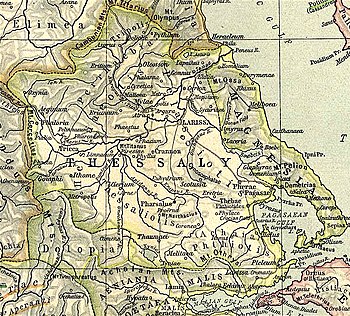Xyniae
Ξυνίαι(Ancient Greek) | |
 The site of ancient Xyniae at Nisí. | |
| Alternative name | Ezeros |
|---|---|
| Location | Koromilia,Phthiotis,Central Greece,Greece |
| Region | Achaea Phthiotis |
| Coordinates | 39°02′18″N22°16′09″E/ 39.038333°N 22.269129°E |
| Type | Settlement, ancientpolis. |
| History | |
| Periods | Hellenistic Greece–Byzantine Greece |
| Cultures | Ancient Greek, Roman, Slavic, Byzantine |
| Satellite of | Thessalian League,Aetolian League |

XyniaeorXyniai(Greek:Ξυνίαι) orXynia(Greek:Ξυνία)[1]was an ancient city inAchaea Phthiotis,Ancient Thessaly,in Greece. In theMiddle Ages,it was known asEzeros(Ἐζερός).
The city was located on the western slopes ofMount Othrys,some 4 km southwest of the modern village ofXyniada(in thePhthiotis Prefecture).[2]The city was strategically located as it controlled the passages along the nearbyLake Xynias(the lake took its name from the city),[1]fromLamiatoThaumaci(modernDomokos).[2]During the second half of the 3rd century BC the city wasAetolian,but passed toMacedoniaafter that, only to be plundered and its population massacred by the Aetolians in 198 BC.[2]In 186/5 BC it passed underThessaliancontrol, and then underRoman rule.[2]
The city was still known under its ancient name in the 6th century AD, being mentioned byStephanus Byzantius;but following the subsequentSlavicinvasions and settlement it disappears, only to reappear in the 9th century as "Ezeros", after the Slavic word for "lake". The name survived until recently for the nearby village ofAgios Stefanos.[3]The medieval town is mostly known as a bishopric (attested since 879), being featured in theNotitiae Episcopatuumuntil well intoOttoman times.[3]A castle was built amidst the ruins of the ancientacropolis;in part its outer walls follow the ancient foundations, but overall it encloses a much smaller space than the ancient fortifications.[3]
In ca. 957 the leader of a local revolt, Theodosios, sought refuge in Ezeros. In the 1198chrysobullofAlexios III Angelosto theRepublic of Venice,it is mentioned as achartoularaton.[3]After theFourth Crusade,the see came underRoman Catholiccontrol (Nazorescensis) for a time, as asuffragan seeof theLatin Archbishopric of Larissa;its first Catholic bishop was elected but never consecrated, and took part at theSecond Parliament of Ravennikain 1210. By 1212 the see was vacant, andPope Innocent IIIgave the bishopric to the bishop of nearby Zetounion (Lamia). The latter exploited it so mercilessly that the grant was withdrawn within a year.[3]The town returned under Greek control soon after that, and in 1250, its bishop, a certain John Xeros, becameMetropolitan of Nafpaktos.[3]
As of the nineteenth century,William Smithremarked that the site of the ancient city was marked by some remains of ruined edifices upon a promontory or peninsula inLake Xynias,[4]a site now called Koromilia[5]or Nisi.[6]
References
[edit]- ^abDictionary of Greek and Roman Geography (1854), Xynia
- ^abcdKramolisch, Herwig."Xyniae".Brill's New Pauly.Brill Online, 2015.Retrieved20 September2015.
- ^abcdefKoder, Johannes; Hild, Friedrich (1976).Tabula Imperii Byzantini, Band 1: Hellas und Thessalia(in German). Vienna: Verlag der Österreichischen Akademie der Wissenschaften. pp.158–159.ISBN3-7001-0182-1.
- ^
 Smith, William,ed. (1854–1857). "Xynia".Dictionary of Greek and Roman Geography.London: John Murray.
Smith, William,ed. (1854–1857). "Xynia".Dictionary of Greek and Roman Geography.London: John Murray.
- ^Richard Talbert,ed. (2000).Barrington Atlas of the Greek and Roman World.Princeton University Press. p. 55, and directory notes accompanying.ISBN978-0-691-03169-9.
- ^Lund University.Digital Atlas of the Roman Empire.

